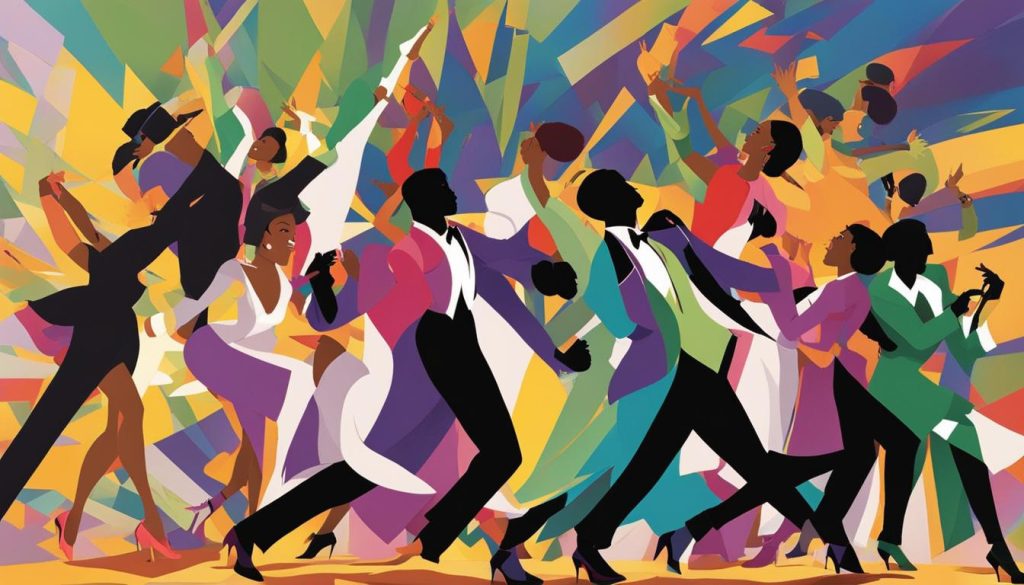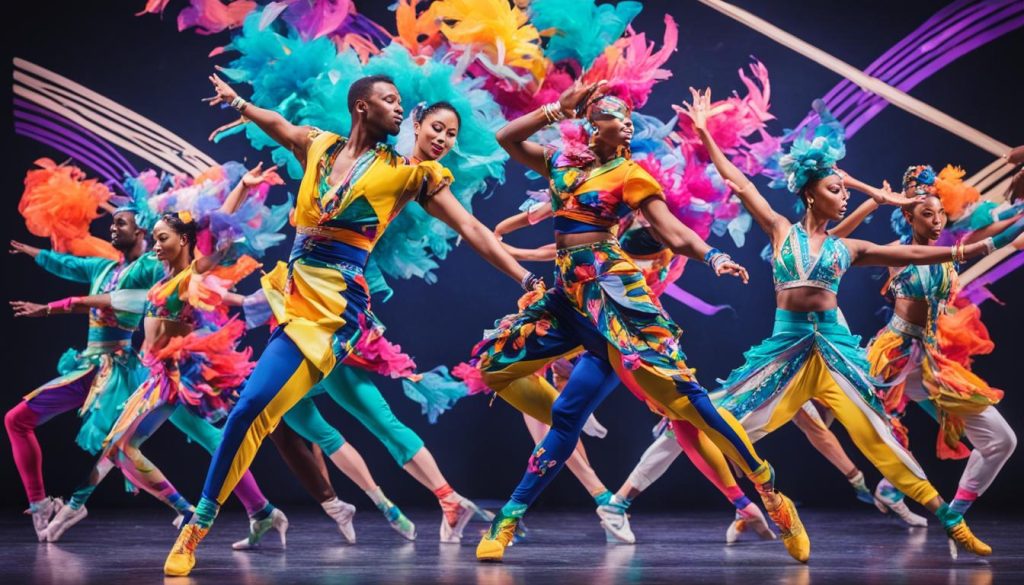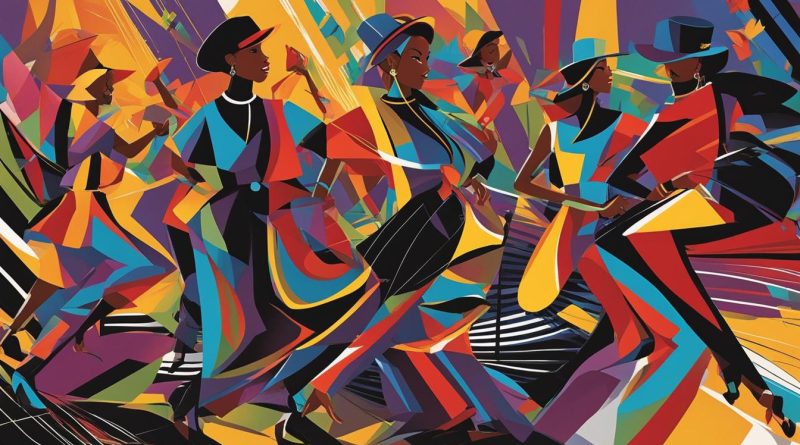Explore Jazz Dance Origins & Techniques Today
Jazz dance is a dynamic and expressive style that originated in the early 20th century within African American communities. Today, it is a popular form of dance that is well-known for its sharp movements, fluidity, and high energy.
In this section, we will explore the origins and techniques used in jazz dance. From its roots in African American culture to its evolution into a unique and influential art form, jazz dance has left a lasting mark on dance culture.
Key Takeaways:
- Jazz dance originated in African American communities in the early 20th century.
- Jazz dance is characterized by its sharp movements, fluidity, and high energy.
- Techniques in jazz dance include isolations, syncopation, and improvisation.
- Jazz dance has left a lasting impact on contemporary dance culture.
History of Jazz Dance
Jazz dance has a rich history that dates back to the African American communities at the turn of the 20th century. This art form evolved as a fusion of African and European dance traditions and emerged as a vibrant new style that incorporated elements of improvisation and syncopated rhythms.
As jazz music gained popularity in the 1920s, so too did jazz dance, particularly in nightclubs and cabarets. The dance form continued to evolve and expand throughout the 20th century, influenced by such iconic figures as Katherine Dunham, Bob Fosse, and Jack Cole.
A notable event in the history of jazz dance was the rise of the Harlem Renaissance in the 1920s and 1930s. This cultural movement celebrated African American art, music, and literature, and helped to foster a greater recognition and appreciation for jazz dance among mainstream audiences.

Today, jazz dance continues to thrive as a dynamic and influential art form, with its origins and rich history inspiring new generations of dancers and choreographers.
Styles and Techniques in Jazz Dance
Jazz dance encompasses a wide variety of styles and techniques, each with its unique characteristics and history. From the suave and sophisticated moves of Fred Astaire and Ginger Rogers to the edgy, high-energy hip-hop infused routines of today, jazz dance has evolved and adapted in response to various cultural influences.
One of the defining features of jazz dance is its emphasis on improvisation, where dancers use intricate footwork and dynamic body movements to express themselves in a spontaneous, fluid manner. Jazz dance also incorporates techniques like isolations, where dancers move specific parts of their body in isolation to create a sharp, angular contrast.
Another hallmark of jazz dance is syncopation, where dancers accentuate beats that fall between the primary rhythm, creating a lively, off-beat cadence that keeps audiences on their toes. Jazz dance also often incorporates elements from other styles like ballet and contemporary dance, creating a fusion of movement and expression.
Famous jazz choreographers, like Bob Fosse and Jack Cole, have contributed significantly to the evolution of jazz dance through their innovative routines and choreography. One of the well-known jazz moves is the “jazz hands,” where dancers open their palms, flick their wrists, and shake their hands in quick, snappy movements.
Whether you’re interested in learning the classic styles of jazz dance or exploring contemporary forms, there is an array of styles and techniques waiting for you to explore.

Conclusion
Overall, jazz dance has a rich and vibrant history that has influenced modern dance culture. From its African American roots to its evolution in the early 20th century, jazz dance has remained a popular and relevant style of dance.
Through various styles and techniques, such as isolations, syncopation, and improvisation, jazz dance has continued to evolve and inspire dancers and choreographers around the world.
While jazz dance has faced criticism and challenges throughout its history, it has persisted as a form of artistic expression and cultural representation.
As dance culture continues to evolve, jazz dance remains an essential and influential part of it. By exploring the origins, history, and techniques of jazz dance, readers can gain a deeper appreciation and understanding of this expressive art form.
Whether one is a seasoned dancer or a novice, jazz dance offers something for everyone. Its energy, creativity, and dynamic movements continue to captivate audiences and inspire future generations of dancers.
FAQ
What is jazz dance?
Jazz dance is a lively and expressive style of dance that originated from African American communities and has evolved into a vibrant art form. It combines elements of ballet, modern dance, and African dance with its own distinctive techniques and movements.
What are the origins of jazz dance?
Jazz dance has its roots in African American communities, particularly in New Orleans during the late 19th century. It emerged as a form of expression and cultural identity, blending African rhythms and movement with European dance styles.
What are the different techniques used in jazz dance?
Jazz dance incorporates a range of techniques to create its unique style. These techniques include isolations, which involve moving individual body parts while keeping the rest of the body still; syncopation, where movements are accentuated on off-beat rhythms; and improvisation, allowing dancers to express themselves freely through spontaneous movement.
Who are some significant figures in the history of jazz dance?
There have been many influential choreographers and dancers in the history of jazz dance. Some notable figures include Bob Fosse, known for his distinctive style and choreography in Broadway musicals, and Katherine Dunham, who combined African and Caribbean dance traditions with jazz dance to create a new form of expression.
What are some popular moves and steps in jazz dance?
Jazz dance encompasses a wide range of movements and steps, including jumps, kicks, turns, and leaps. Common moves include the jazz square, where dancers cross their feet and step out diagonally, and the shimmy, which involves rapid vibrations of the shoulders or hips. Other popular steps include pas de bourrée, pirouettes, and jazz walks.
How is jazz dance relevant in contemporary dance culture?
Jazz dance continues to be influential in contemporary dance culture. Its distinctive techniques, energy, and expressive qualities have shaped and influenced other dance styles. Jazz dance is often seen in music videos, stage performances, and popular dance competitions, demonstrating its enduring appeal and relevance.
